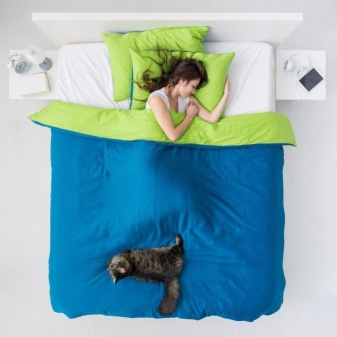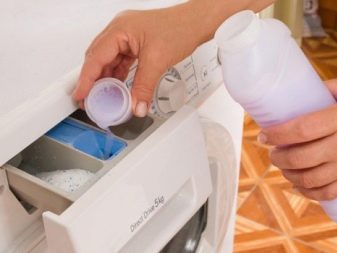How often should bed linen be changed?

It is always pleasant to sleep on bed linen that smells of cleanliness. For a full and comfortable sleep, you should pay special attention to its cleanliness. How often should the linen be changed and how should the sets be washed correctly? Answers to all questions in our material.



How does the laundry get dirty?
On average, each of us spends eight hours a day in bed. This is how long it takes for a full and healthy sleep. In order for the sleep to be pleasant and comfortable, each person gets a comfortable bed, high-quality mattresses, pillows and blankets. Particular attention is paid to the choice of bed linen.
A set of underwear should be of high quality and naturalness, because this directly affects our sleep.
Despite the fact that a person takes a shower or a bath in the evening, the bed linen still gets dirty and should be changed regularly. How and what do the sheets and other accessories get dirty?


The most basic problem of all houses and apartments is dust. Dust accumulates not only on furniture and various objects, but also on bedding. Of course, it is almost impossible to discern dust particles on sheets or pillowcases, but this does not mean that they are not there. Every morning, making the bed, shaking the blanket or the sheet can be changed, as dust columns rise in the sun. Dust is a serious allergen that can harm the body. The children's organism is especially sensitive to it.
Anyone's skin contributes to the rapid contamination of bedding. If a person is used to sleeping without pajamas, then sebum will rather quickly be absorbed into sheets and pillowcases, especially in the hot season when the body sweats. The skin tends to renew itself. Small parts of the keratinized cover also remain on the bed. Of course, it is impossible to see them, since they are very small. For these reasons, bed linen changes color, an unpleasant odor and stains appear. Such soiled laundry can cause itching or an allergic reaction.


Particles of dirt can still remain on the body, for example, if you just rinse the body with water, without soap and washcloth, and do not swim. If you do not wear slippers on the way to the bedroom, then all the dirt from the feet will end up on the bedding and this is another reason for its contamination.
Those who like to eat cookies before going to bed or drink morning coffee in bed themselves pollute their sleeping place with food particles. No matter how carefully you eat, small crumbs can still remain on the bed.
If there are pets in the house, then particles of their wool and fluff will fall on the linen sets. Of course, this will negatively affect the cleanliness of the sheets.


All of the above factors affect not only the cleanliness of the laundry, but also health. Scientists have proven that bedding contains many different microorganisms, which are almost impossible to get rid of.
If bed linen is not changed in time, the situation will worsen, bacteria will spread with a vengeance. All this will negatively affect the general state of health, weaken the immune system and can provoke the appearance of allergic diseases.


Optimal kit change frequency
Many people wonder how often bed linen should be changed at home? Of course, the more often you do this, the better for you. Timely bed linen change can contribute to a comfortable and proper sleep.Within five or six days, the fabric is easily clogged with dust particles and stops "breathing".
As a result, a person may feel discomfort during sleep, sweat more and more often. Soiled laundry has a negative impact not only on your overall health, but also on the health of your skin. After sleeping on such underwear, rashes, irritations, and so on may appear.
Due to the contamination of the kit, full sleep is disturbed, the next morning a person will feel tired and irritated.


Adults
Adults should change their bedding once a week. This is if the person is completely healthy. In the event that there is a patient in the house who is constantly in bed, then the kit must be changed every two days. If you spill something on the sheet or a stain appears on the linen, then the entire set should be changed immediately.
Considering the fact that the sheet and pillowcase get dirty much faster than the duvet cover, it can be changed every ten or fourteen days.
By the way, the frequency of linen change also depends on the season. For example, in the hot season, when the body sweats a lot, you can change the kits every two to three days, otherwise a heavy and unpleasant odor appears. In addition, in summer and spring, the windows in the house are open most of the time. Therefore, a lot of dust and dirt gets into the room. In the winter season, you can change your linen every ten days.



For children
The body of a child is very different from that of an adult. For this reason, there are certain norms and recommendations regarding how often you should change the linen on a baby bed.
For babies under one year old, it is recommended to change the set of underwear every five days. Of course, in the event that a newborn gets dirty on the sheet, then you need to change it immediately. The same goes for the bedding of preschool children.
Children seven and older need to change bedding sets once a week. In the event that the child is sick, then the shift should be carried out every other day.



When a child is sick, he has a fever and he sweats a lot during sleep, the pillowcase and sheet should be changed every time he sleeps. The baby should sleep on clean and dry clothes.
Teenagers, given their age-related changes, should change bedding every five to six days. In addition to the fact that parents need to timely change the bedding on their children's beds, you should monitor the personal hygiene of the babies. Children often go to bed without showering or washing. All this will negatively affect health, immunity and cleanliness of linen.


Washing rules
In order for all bedding sets to be in perfect condition, they must be properly washed. There are some subtleties that every housewife must know.
- Before you start washing, be sure to check the composition of the fabric and the recommendations for washing the kit. All features of the fabric, its composition and method of washing must be indicated on a special label or label for bed linen. Each fabric requires an individual approach and this must be taken into account.
- In the event that a set of linen is made entirely of cotton or linen, it must be washed at a temperature of no more than 60 degrees.
- Colored sets should not be washed at too high temperatures, this will negatively affect the quality of the products. Better to limit yourself to 40 degrees. In addition, for such kits, it is best to use special detergents that do not contain active bleaching agents. Such recommendations will help to preserve the original color of the kit for a long time.


- To ensure that the snow-white fabrics do not lose their appearance, it is recommended to add very little bleach during each wash. Bleach, which contains chlorine, is great for white fabrics. Such a tool not only returns whiteness, but also helps to destroy harmful organisms.
- Fabrics such as silk should be washed with a special wash cycle.Silk set can be refreshed only with the delicate wash cycle. It is better to turn off the spin, as this spoils the capricious fabric fibers. In addition, it is worth remembering that silk products do not withstand repeated washing, so such sets should be used less often.
- In the event that the laundry is heavily soiled, it is better to soak it first and only then start washing.
- It is recommended to wash pillowcases and duvet covers from the wrong side.
- When you just bought a new set of bedding today, be sure to wash it on the recommended mode before making it. Before being sold, fabrics are impregnated with special agents that may cause irritation or an allergic reaction.


- The washed laundry must not be left in the basin or drum of the washing machine for a long time. Dry it immediately. In the event that you leave it for at least an hour or two in a wet, crumpled form, then the sheets and pillowcases will begin to rust. As a result, an unpleasant odor will appear, the fibers of the fabric will begin to deteriorate. When there is no separate apparatus for drying clothes in the house, you can hang it on special metal dryers. It is recommended to dry the laundry at home, as it will be covered with invisible dust particles outside.
- It is quite possible to dry the linen on the street, in the fresh air if you live outside the city or in a private house. It is especially good to hang out laundry after rain, when there is practically no dust in the air.
- Colored and bright products are not recommended to be left in direct sunlight, as the fabric will become more faded and ugly.
- After the entire set has dried, be sure to iron all the bedding and carefully fold it on a clean shelf in the linen closet.
- To make the laundry easier to iron and not to leave any wrinkles or folds, ironing should be started while it is still a little damp.
- If the bedclothes are brightly colored or have embroidery, they should be ironed exclusively from the wrong side. This ironing method will keep the color saturation for a long time.
The method of washing laundry is in the next video.













The comment was sent successfully.